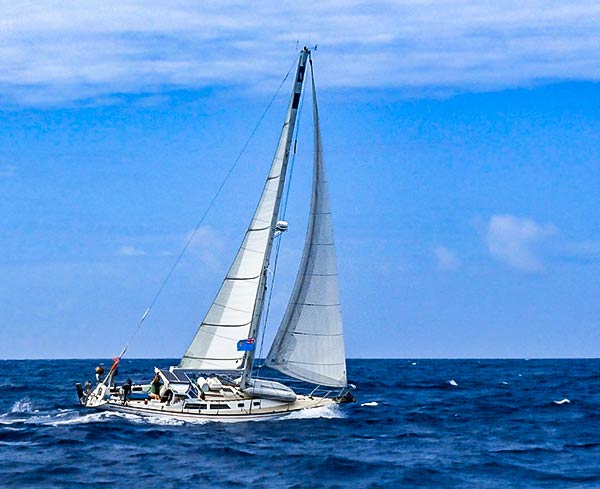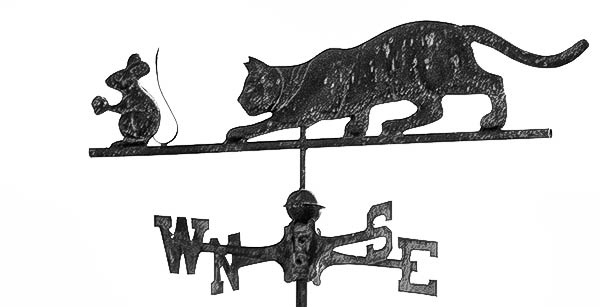August 15, 2019

Reading back over our first year of cruising in French Polynesia, I was struck by how intensely our schedule was affected by the wind. Of course, our schedule is always affected by the wind, but having only a three-month visa and a lot of ground to cover took the situation up to a whole new level, especially with all the marginally protected anchorages and reef passes we had to contend with.
It’s hard to convey to a new cruiser just how big a factor the wind is, not just on passages but on day to day cruising life. I guess I’d compare it to being a mouse in a home with a cat. There’s a kitchen with lots of food in the pantry and crumbs dropped about, but the mouse needs to work around the cat. Here’s a little story to illustrate this:
Behind the wall, a group of mice is waking from their daytime slumber. The house is dark and quiet, and sunflower seeds were spotted earlier in the day’s grocery collection. Those seeds are now stashed in the pantry, and it’s a feast waiting to be enjoyed. But wait, was that the cat? Yep, the cat is up and around in the next room. What do you do; what do you do? Caution and wisdom (prudence) would suggest that the mice be patient, to otherwise occupy themselves behind the wall until the coast is clear. But the temptation of those seeds is great; and some of the mice are bored and hungry. “Yea, that stupid cat is up, but between his laziness and the fact he stuffed himself on canned tuna earlier, I don’t think he’ll be an issue. Besides, I’ve outrun much bigger cats than him; so I’m going for it.”
There are three possible outcomes to this scenario. In one, the mouse might well get lucky and have that feast of sunflower seeds all to itself. More likely, it will dash back through the hole, eyes wide, shaken and humbled after a harrowing experience. “That cat might look like a basketball with four legs, but he moves like Nadia Comaneci.” The third scenario, of course, is that the mouse is never seen again.
What does the life of a mouse have in common with cruising? More than you’d think. We were well schooled during our seasons cruising Hawaii and Mexico in how imperative it is to not fight the wind and to keep informed enough so we wouldn’t get caught out in a blow. In essence, we learned we are the mice, and the wind and the sea are the cats. This was a vital lesson, but unfortunately many new cruisers are pretty clueless as to just how dangerous “the cats” can be and make the fatal mistake of underestimating the speed, agility and power of Princess Kitty Powder Puff when she’s on the prowl.
We’ve seen it again and again over the years: determined cruisers who have a plan or a schedule and just aren’t prepared to let nature decide when and where they can go. They insist on making a passage thinking they’ll buck it up and take what comes. The problem is the boat has to take it, too, and boats are not as invincible as we like to think. The forces of nature, the wind and the sea, are huge. It doesn’t do much good to be safely wedged in the cockpit if the boat starts falling apart around you.
Every cruiser knows there’s risk involved in crossing an open ocean. What comes as a complete surprise to many is how significant that risk can be in a lagoon or amid scattered islands.
What makes me think of this is a friend of ours, currently cruising in New Caledonia, who wrote in his blog of watching two boats beating hard into rough conditions in an effort to get to an island about 40 miles to the southeast. New Caledonia has the longest continuous barrier reef in the world, creating a massive lagoon with islands dotted throughout. Looking at the chart, you’d think this would be a pleasant cruising ground with all that protection from the open ocean. But between the shallow water and strong funneled winds, this area can give a pretty impressive ass-whopping to anyone who decides it’s safe to take on the elements here.
Our friend heard one of the boats come up on the radio and tell the other boat that they were turning around and heading back to the mainland (a smart mouse, that one). The other boat was bound and determined to keep going, and not much later, down came their mast. This boat could have been patient and waited for a better time, but no, they must have had a schedule. Well, it seems they now have a very different schedule than they could have imagined.
In a similar story, we were at an anchorage in south Tonga. One cruiser, an experienced one, was planning to go to the Ha’apai island group to the north when the wind was forecast to be 20, gusting to 25 knots. That doesn’t sound so bad, but we’d been to the Ha’apai and the combination of shallow water and flat islands makes that area rather nasty in windy conditions. There are large swells, waves going every which way, and very little in the way of protected anchorages.
I looked out and noticed their boat heading off. I was going to mind my own business, but Rich could’t let them go without saying something. He called them on the radio and warned them about the forecast winds. The gentleman responded that he knew this and somewhat annoyed added, “We’ve all seen 20 knots.” Rich didn’t argue and we watched them go. Later, we heard they had a terrible trip and their autopilot was badly damaged. They made it to the first anchorage for the night but the next day changed their plans and hand steered to the northern island group (probably to deal with their broken auto pilot). So much for their Ha’apai plans.
We’ve seen many such incidents over the years, generally people going out, full of confidence and bravado (“We’ve all seen 20 knots, pal”) only to return with their tails between their legs. Yep, those are two bad-ass cats, that wind and sea. They can catch you, they can have their way with you, and if they feel so inclined, they can kill you.
So wow, how do we ever go anywhere? Well the cat does go away, leaving the mice to play. He goes outside, he takes naps, and he goes to the vet. The trick is to wait for those times. We all push our luck at times, but we need to be aware that the more we do, the more likely it is we’ll run into the cat. It’s best to be flexible, to have a soft schedule. It’s essential to make plans, but it’s best to think of them more as hopes than a hard-core itinerary. This becomes especially true when trying to entertain, pick up, and drop off visitors, particularly when those visitors don’t understand why “a bit of wind” should affect their trip. They came here to sail; so why aren’t they sailing yet? It’s wise to only invite friends who can take no for an answer.
Now back to what I was talking about earlier, a reminder to the smart mice who know better than to fight the ocean or to try to ride out a windy period in a marginally protected anchorage. Even experienced cruisers who do understand this have a tendency to forget just how much of the time those darn cats can be up and about. We get lulled by the seasons where there seem to be plenty of mild wind periods, then feel affronted by windier times.
In essence, there are always mild periods, and there are always windy periods. The only thing that changes is the ratio of one to the other. This brings up the many times we’ve heard cruisers lament, “This has been such a windy season!” But prevailing trade winds by definition blow 15 to 25 knots; so it might be more accurate to call it a normal season and lament that it’s not an especially mild one.
Like cats, those trades are always there, they just might be more active at times. The hard truth is that it’s wonderful to look at an area and make lovely plans for the season, but you’ll be reminded you can only move some of the time and might only complete a portion of your plan. This can be a bitter pill to swallow, a bit like trying to get a cat to swallow a pill. (Yea, I’m a bit cat obsessed.) Bottom line: You don’t get to decide your schedule; nature will decide it for you. Sometimes she’s kind, and sometimes she decides that no, you will not be going that area you hoped to visit.
Over the years I have nicknamed the process of dealing with wind “Weather Chess,” in that it’s much like a game where you have to think several moves ahead while making contingency plans. We plan our moves, then wait to see what our opponent, the wind, will do. The wind makes its move, so we have to study the board so we can make our next move. This is a game that never stops, but it’s much more intense at times than at others.
What to do? Well you can try prayer or witchcraft, but the most effective thing to do is learn to be patient and always have a plan B and C (and even D and E). Also realize that while you may want to have guests fly in and spend some time with you; you can’t promise them anything as far as an itinerary. A friend told us that he advises his guests that they can choose where to meet or when to meet, but not both. Words of wisdom from a smart mouse.–Cyndi







